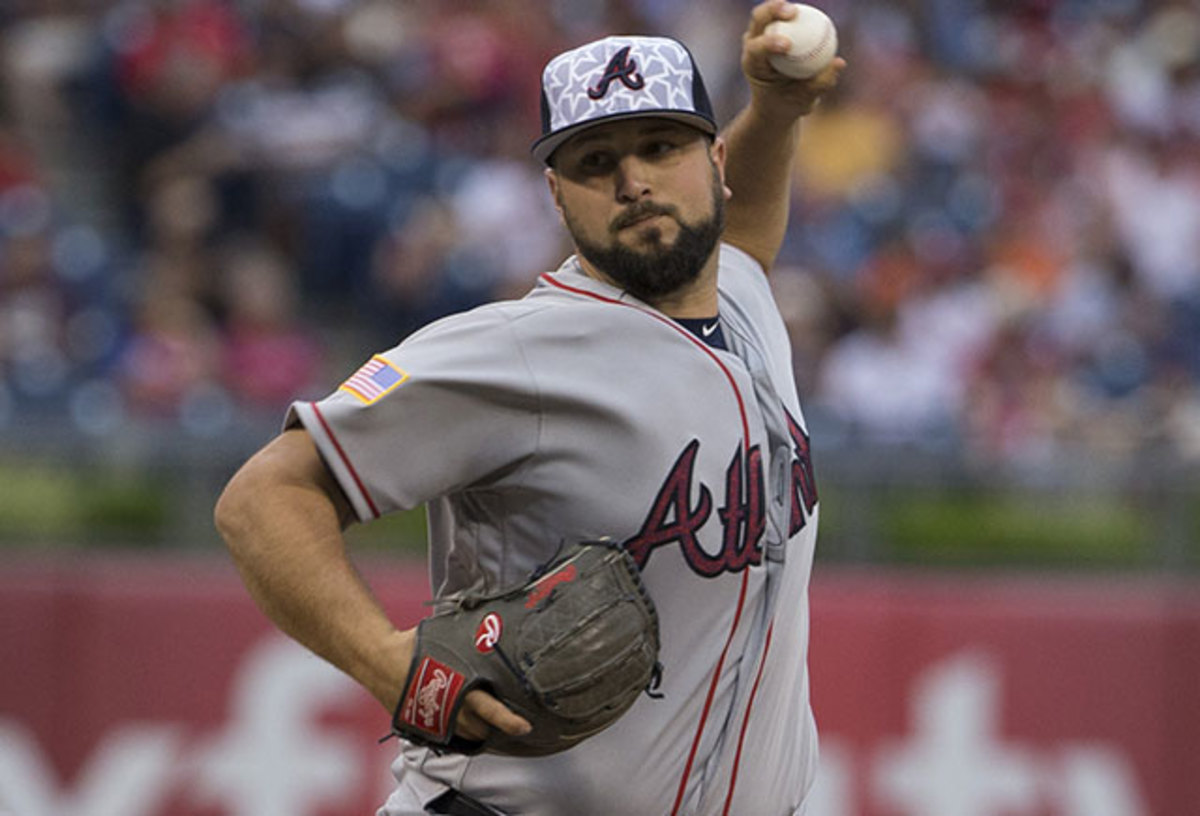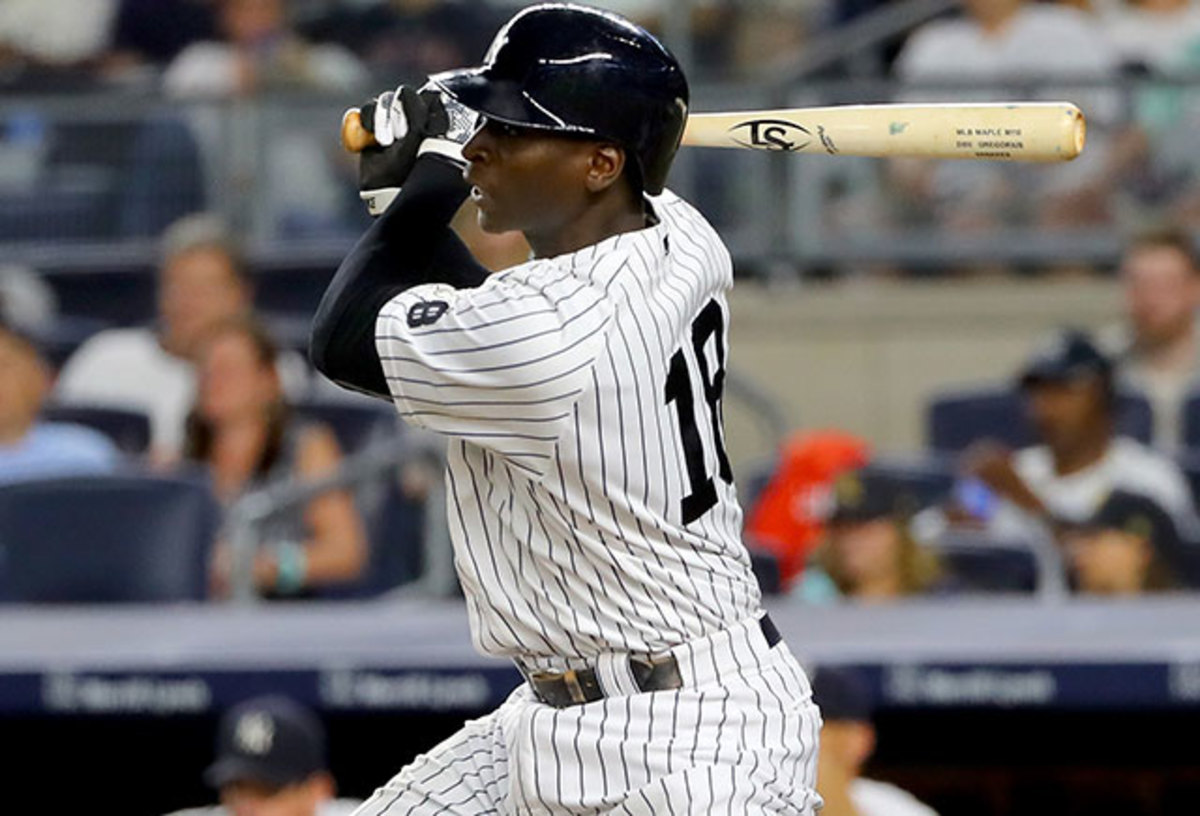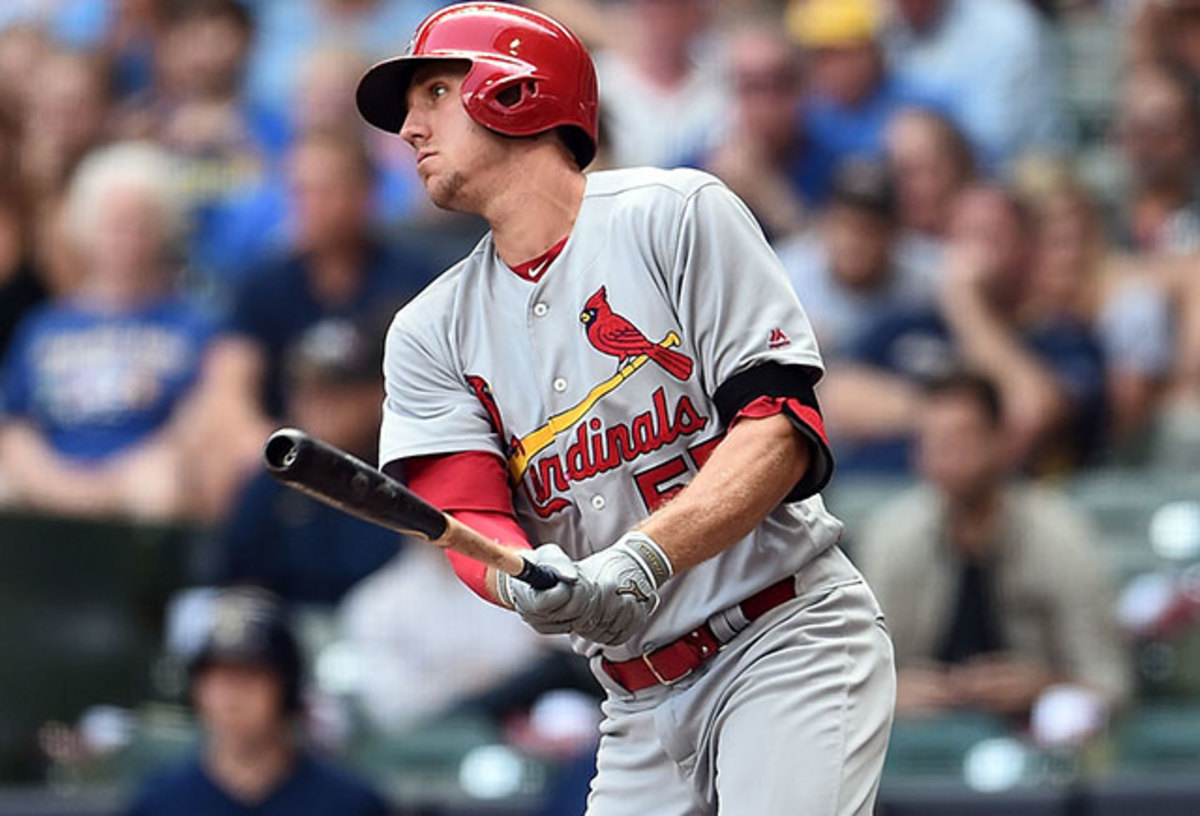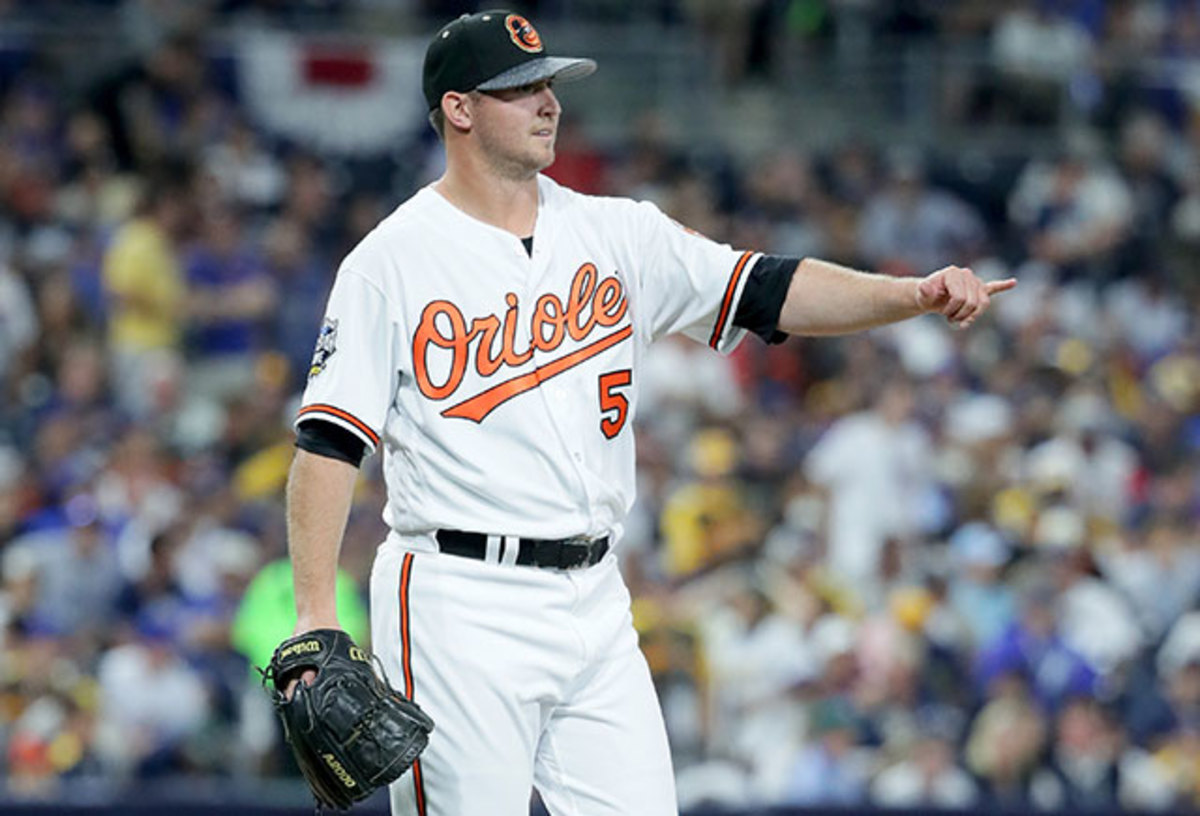The 30: Underrated players get their due in this week's power rankings

The All-Star Game gave 68 of the game’s brightest stars a chance to enjoy the accolades of the crowd in San Diego, and to acknowledge the respect of the fans and managers who tapped them to play. But we have far more than 68 players making an impact this year in the big leagues, many of those not receiving much attention for their excellence.
Today, we examine four of those underrated performers. The Braves struck gold with an impressive rookie reliever. The Yankees found a building block amid a lineup full of old-timers. The Cardinals have another homegrown success story. Meanwhile, the Orioles’ closer is a two-time All-Star and still underrated given his dominance with just one pitch.
Sing the praises of the unsung. It’s Week 15 of The 30.
Best Opportunity For Baseball-Related Cheese Puns: Yangervis Solarte
Hosting the All-Star Game aside, Padres fans haven’t had too many opportunities to cheer this season. The grand experiment of the 2014–15 off-season failed, and the Friars have been unloading top players in the past couple weeks, with closer Fernando Rodney and staff ace Drew Pomeranz now wearing different uniforms.
Solarte, and a plate of nachos, came to the rescue. Up 4–1 in the ninth inning Friday against the Giants, Solarte tracked a foul pop by Angel Pagan toward the stands behind third base. The ball kept drifting to the right, to the point where he knew he’d have to jump into a phalanx of fans if he hoped to catch it. Solarte scooted over, got his bearings, then went into a full-on dive.
Third base umpire Ed Hickox hustled in, wanting to ascertain what had happened. Just then, Solarte emerged, with the ball in his glove. The capper was what happened next: Hickox reached into Solarte’s glove, pulled out the ball … and found a huge glob of nacho cheese on it. Go with obvious puns like “nacho ordinary catch,” or delve into other cheese-related humor by declaring it “a really gouda play.” Either way, hats off to Solarte for risking serious injury (and a face full of gooey snacks) to make the out.

Digging Deep
Unheralded rookie Hunter Cervenka has been a rare bright spot for an abysmal Braves team.
30. Cincinnati Reds (34–58 record, minus-160 run differential, last week: 30)
29. Atlanta Braves (32–60, minus-116, LW: 29)
28. Tampa Bay Rays (35–56, minus-73, LW: 28)
27. Minnesota Twins (33–58, minus-78, LW: 27)
26. Oakland A’s (40–52, minus-69, LW: 26)
25. Milwaukee Brewers (39–51, minus-70, LW: 24)
24. Los Angeles Angels (40–52, minus-5, LW: 25)
23. Arizona Diamondbacks (40–53, minus-58, LW: 23)
If the Padres have had trouble finding rays of hope this season, imagine how bad it’s been for the Braves. They own the worst record in baseball, sit last in the majors in runs scored, and even a hypothetical 24-game winning streak combined with a 24-game losing streak for everyone else in the NL East still wouldn’t get them into first place. That makes it hard to find many pleasant surprises on your roster.
But if you’re a fan of long shots, you’ve got to be thrilled for Hunter Cervenka. A native of Baytown, Tex., Cervenka was drafted by the Red Sox in the 27th round back in 2008. Cervenka toiled in Boston’s system before getting shipped to the Cubs in a trade for Marlon Byrd; he was so lightly regarded that the Sox made him the player to be named later in the deal. Cervenka pitched for Chicago for three years before the North Siders released him in May 2015. When a relief pitcher with seven years of professional experience caps his time with an organization by posting a 11.08 ERA at Triple A, you might figure that’s the end of the road, and that the dream of pitching in the majors won’t ever come true.
• Picking X-factors for each division for MLB's second half
Fortunately, the downtrodden Braves didn’t have much pitching depth at the higher levels of their organization. So on July 7, 2015, they picked up Cervenka for the cost of … nothing. He immediately turned his fortunes around, tossing 16 2/3 innings at Triple A Gwinnett without allowing an earned run last year and started this season with three scoreless innings at Double A Mississippi. So when the Braves’ painfully thin major league roster needed a live arm out of the ‘pen, Cervenka got the call. Nearly eight years of riding buses had finally paid off.
Cervenka has rewarded management’s faith in him, too. Pitching mostly as a situational lefty who sometimes faces just one batter, he’s appeared in 40 games, firing 27 2/3 innings. In that span, he’s allowed just 15 hits and one home run, striking out 32. His most frequently used pitched is a slider that’s nearly unhittable, at times sneaking into the low 90s and holding opponents to a microscopic .091 batting average. He also generates plenty of ground balls with that slider and a sinking fastball, racking up a ground-ball rate near 51% for the year. Caveats apply: He’s struggled at times with command and walked a jarring 17 batters this season, and 27 2/3 innings don’t automatically portend a long and glorious career.
Sure, a stingy LOOGY is little more than a nice luxury on a last-place team, and multiple players far more important to the team’s long-term success continue to play in the minors, with a Dansby Swanson-Ozzie Albies middle infield dominating in the new ballpark from 2017 through ‘22 as the most exciting scenario. Still, if you’re the Braves, you take the good tidings where you can get them, and if you’re a 27th-round draft pick, you’re just happy to be in the Show, getting batters out.

Stopping Short
Didi Gregorius is a keeper on a team that needs to trade for a lot more of them.
22. Philadelphia Phillies (43–50, minus-92, LW: 21)
21. San Diego Padres (41–51, minus-42, LW: 22)
20. Colorado Rockies (42–49, minus-5, LW: 20)
19. New York Yankees (45–46, minus-37, LW: 19)
18. Chicago White Sox (45–46, minus-27, LW: 17)
17. Kansas City Royals (46–45, minus-26, LW: 18)
16. Pittsburgh Pirates (47–45, minus-2, LW: 16)
15. Seattle Mariners (46–46, plus-41, LW: 15)
For decades, the Yankees have run a split front office. On one side is the Steinbrenner family and team president Randy Levine, along with the rest of the organization’s Tampa contingent. On the other is Brian Cashman and the rest of the baseball operations department, dealing with day-to-day happenings in the Bronx.
Sometimes the two factions agree, and everything runs smoothly. But with two weeks left until the trade deadline, a huge schism has emerged. With the Yanks struggling just to stay close to .500 and many superior teams ahead of them, the logical move is to trade multiple veterans for younger talent that could help the club in the future. The Tampa faction begs to differ. So now, with a stack of prime trade chips toiling on a team that’s highly unlikely to make the playoffs, the Yankees sit at a stalemate. For a team that boasts just two starting position players under 32 years old, it’s a really bad spot to be in.
• Verducci: David Ortiz on why his decision to retire is absolutely final
One of those two position players is just 26 years old—the rare Yankee who is actually in his prime. Long regarded as a harmless slap hitter, he has already set a career high in home runs in a season and is on pace to establish new personal bests in batting and slugging averages. Batting .299/.330/.471 and playing a pivotal up-the-middle position, Didi Gregorius has won new admirers this season.
The question is whether Gregorius’s gains are sustainable. A closer look at his underlying skillset leaves room for doubt. By line-drive percentage, hard-hit rate and pull frequency, he’s the same hitter that he was last year, when he batted a weak .265/.318/.370. Twice as many of his fly balls have sailed over the fence this season for home runs, which could be a mark of truly improved power or just a statistical aberration. Gregorius is striking out less frequently than he ever has before, which bodes well for his ability to put up strong batting averages going forward. But he’s also a supreme hacker, ranking among the American League leaders in swing rate and near the bottom of the league in walk rate.
Then there’s his defense. By reputation, Gregorius is regarded as one of the slickest fielders in the league. But this season, his defensive numbers have fallen sharply: If advanced metrics like Defensive Runs Saved in partial-season samples are to be believed, Gregorius has been one of the worst defenders in the league at his position. A reasonable reading of his overall resume has Gregorius as a flawed but still better-than-average player who offers real value at a premium position and offers team control through 2019.
That, along with a strong bullpen and Masahiro Tanaka—a very good righthander who’s a half-notch below the game’s elite and also comes with injury concerns—is the best the Yankees have at the major league level. With no true stars and so few young players on the major league roster, there’s an argument for making everyone else available and seeing what the market might bear. At the very least, aggressively shopping free-agents-to-be Aroldis Chapman and Carlos Beltran seems like a no-brainer for a team that’s low on top talent and outgunned by three divisional rivals, now and for the foreseeable future—yet even that modest proposal is far from a sure thing.
For the Yankees’ sake, here’s hoping the Tampa crew backs down—ideally, as soon as possible.

Talent Factory
Yet another batch of dynamic young players is doing big things in St. Louis this year. So why aren’t the Cardinals winning more?
14. Detroit Tigers (48–44, minus-1, LW: 14)
13. New York Mets (49–42, plus-25, LW: 13)
12. St. Louis Cardinals (47–44, plus-90, LW: 11)
11. Miami Marlins (49–42, plus-0, LW: 12)
10. Houston Astros (50–42, plus-40, LW: 10)
9. Los Angeles Dodgers (52–42, plus-57, LW: 9)
Aledmys Diaz has been the Cardinals’ biggest pleasant surprise this season, and it’s not particularly close. But he’s also had glowing features written about him and made the NL All-Star team, making the rookie shortstop something of a known commodity. The mantle of unsung hero thus falls to second-year outfielder Stephen Piscotty, who has something in common with Diaz: They’re both 25-and-under stars on a team that’s chock full of them.
Piscotty broke into the majors last season, making his major league debut on July 21. Like so many Cardinals farmhands before him, he was immediately given a crack at regular playing time. He didn’t disappoint, batting .305/.359/.494 and finishing sixth in NL Rookie of the Year voting despite playing just 63 games. Granted an everyday gig this year from day one, he’s posted similar numbers, hitting .295/.371/.486. There are signs of progress that portend bigger things, including more walks and fewer strikeouts. Best of all, Piscotty is just 25 years old with the equivalent of one full season in the big leagues, offering hope for future improvement as he gains experience.
• Astros' infield gets more crowded with addition of Yulieski Gurriel
The emergence of Piscotty and Diaz isn’t that big a surprise when you consider St. Louis’ track record over the past decade or so. The Cardinals have made the playoffs 12 times this century, winning four NL pennants and two World Series. They’ve posted just one losing season since 2000. Consider the length of that timeframe, and you realize that they’ve done so with different generations of players leading the charge, too. Setbacks like the free-agent departure of Albert Pujols, or the diminishment of the talents of top stars like Chris Carpenter due to aging and injury, have been handled and swept aside thanks to a steady influx of young, mostly homegrown talent. Among the 13 starters in the Cards’ lineup and rotation, six are in their age-25 season or younger.
That brings up the million-dollar question: Coming off a 100-win season, with talent and youth both on their side, why aren’t the Cardinals winning more this season?
You can count a few individual player performances among the biggest reasons, with veteran leftfielder Matt Holliday, centerfielder Randal Grichuk, second baseman Kolten Wong and deposed closer Trevor Rosenthal among the players who’ve taken the biggest steps backward in 2016. But there’s another factor in play, too: The team that in many ways fared best in the toughest spots last season hasn’t performed nearly as well in similar situations this year. No team in the majors was stingier last season with runners in scoring position, as St. Louis pitchers held opponents to a tiny .210 batting average in those sports. This year, with the core of the same pitching staff back in the fold, they’re allowing a middle-of-the-pack .254 batting average with runners in scoring position.
The team’s situational performance looks even worse if we look at cluster luck, a metric tracked by researcher Ed Feng that measures how often teams scatter hits while pitching and bunches hits together while hitting. By that standard, Cardinals pitchers have been the second-least opportunistic bunch in baseball this season after ranking near the top of the league last year. Here’s one more nugget to consider: Combine the Cardinals’ strength of schedule to date with their run differential, and they rate as the third-best team in the majors, despite their mediocre performance. Yes, we can chalk up a lot of that to Rosenthal frequently melting down, blowing late-game leads and skewing the Cards’ record in close games. But Rosenthal is out of that job, and Seung-hwan Oh, Kevin Siegrist, Matthew Bowman and others have helped picked up the slack out of the pen.
The question then for the Cardinals is if their luck, along with the performance of several slumping players, will turn around fast enough to make another playoff run happen. While nobody can say for sure, they do have an ace up their sleeve in Alex Reyes. Few starting pitchers at any level of pro ball can match Reyes’s huge swing-and-miss stuff, which has produced 67 strikeouts in just 46 1/3 innings this year. Here’s the kicker: Reyes is a phone call away at Triple A Memphis, and he’s just 21 years old. The beat goes on.

That Sinking Feeling
Baseball has a new Mariano Rivera, and he pitches for the Orioles.
8. Texas Rangers (55–38, plus-11, LW: 6)
7. Toronto Blue Jays (52–42, plus-75, LW: 5)
6. Baltimore Orioles (53–37, plus-40, LW: 7)
5. Boston Red Sox (51–39, plus-69, LW: 8)
4. Cleveland Indians (54–37, plus-88, LW: 4)
3. San Francisco Giants (57–36, plus-67, LW: 1)
2. Chicago Cubs (55–36, plus-144, LW: 3)
1. Washington Nationals (56–37, plus-114, LW: 2)
Zach Britton is a two-time All-Star, so we can’t grant him any diamond-in-the-rough status. But the Orioles’ closer isn’t merely one of the better relievers in the game. He’s the most predictable pitcher in baseball … and yet no one can hit him.
On April 30, Britton allowed an earned run against the White Sox. Since then, the lefty has been untouchable. In 29 appearances, he’s allowed zero earned runs, just 16 hits and nine walks, striking out 34; in 23 save opportunities, he’s saved all 23. His 29 2/3 consecutive innings without allowing an earned run is the longest active streak in the majors.
• Verducci: Forecasting second half for MLB's top teams, players, more
Though Britton misses tons of bats, he also owes much of his success to his incredible ability to generate harmless contact. When batters hit balls into play against him, they smack ground balls an inconceivable 78.9% of the time, by far the highest rate in the league. What makes that accomplishment even more amazing is Britton’s comically limited arsenal of pitches. He’s more or less a one-pitch pitcher, firing a sinker 91% of the time and dialing it up to 98 mph (on average) and occasionally into triple digits. Everyone in the stadium knows what he’s going to throw, and yet no one can hit him. Britton can only claim 2 1/2 years of dominance in the majors, but you see the one-pitch repertoire and total dominance and can’t help but invoke the name of Mariano Rivera.
The bigger question for the Orioles is if they can hang onto first place in the AL East with the roster they have. In Britton and righthander Brad Brach, the O’s employ the two relievers with the lowest ERAs in the league (minimum 30 innings pitched). Thing is, Brach already leads all AL relievers in innings (51 1/3) and is on pace to approach 80 appearances, making you wonder if he can hold up all season—let alone the postseason—under that massive workload. Moreover, Brach, Britton and the rest of the ‘pen have had to shoulder a disproportionate amount of the load for the pitching staff, given the mediocre to terrible results put up by every starter not named Chris Tillman.
With the Red Sox acquiring numerous reinforcements at the trade deadline, the Blue Jays well armed with both a killer offense and superior rotation and the O’s relying almost entirely on their powerful lineup and stingy bullpen four days out of every five, a trade some time in the next two weeks could be in the offing. Rumors have multiple 20-something Rays starters on the market, with other names—including the Braves’ Julio Teheran, the Yankees’ Nathan Eovaldi, the Angels’ Matt Shoemaker and the Athletics’ Rich Hill (if he can shake his blister woes)—emerging as trade candidates. Landing one of those arms, or a similarly talented pitcher, could hold the key to the Orioles’ chances of holding on and pulling off another even-year surprise.
